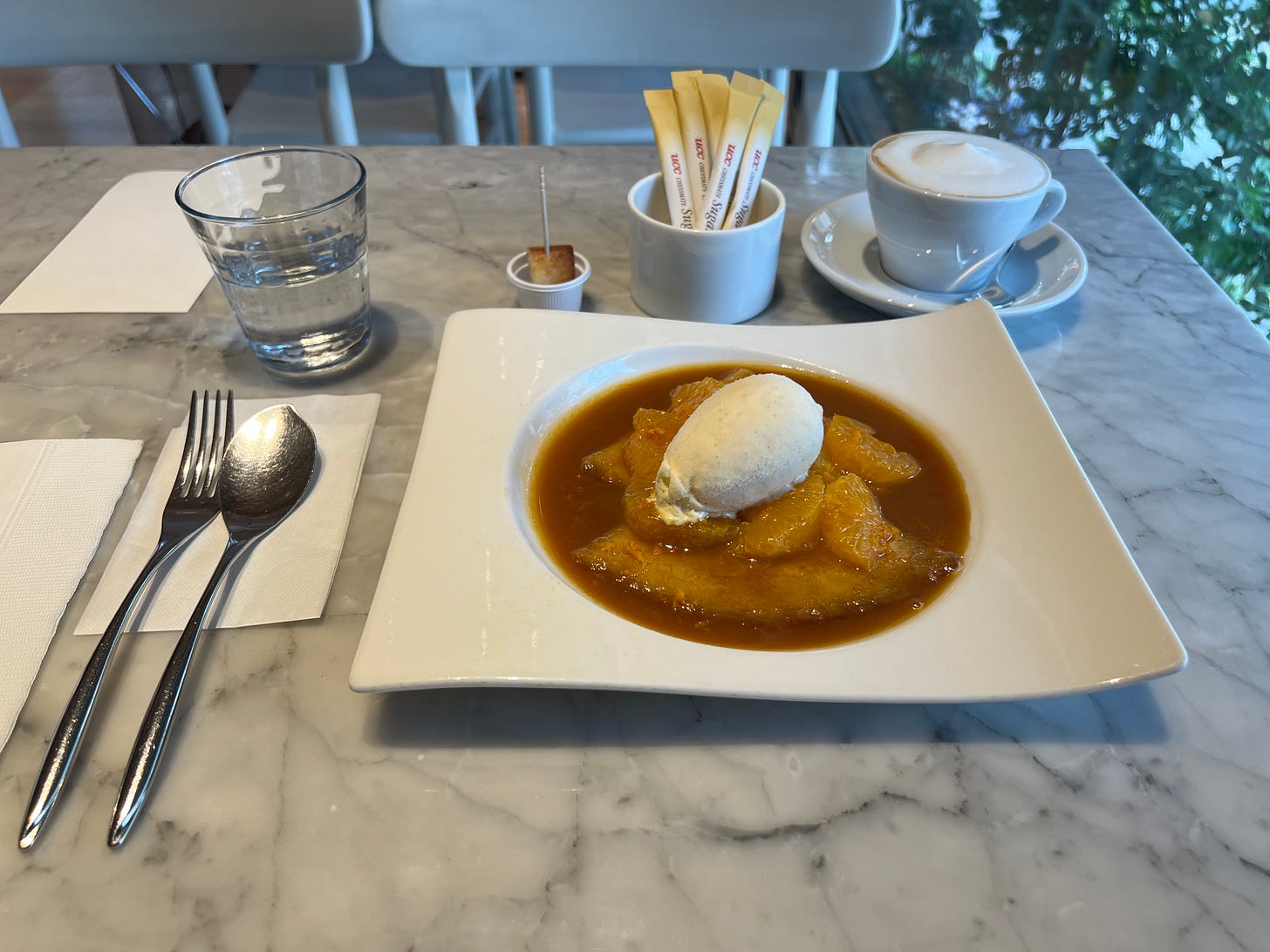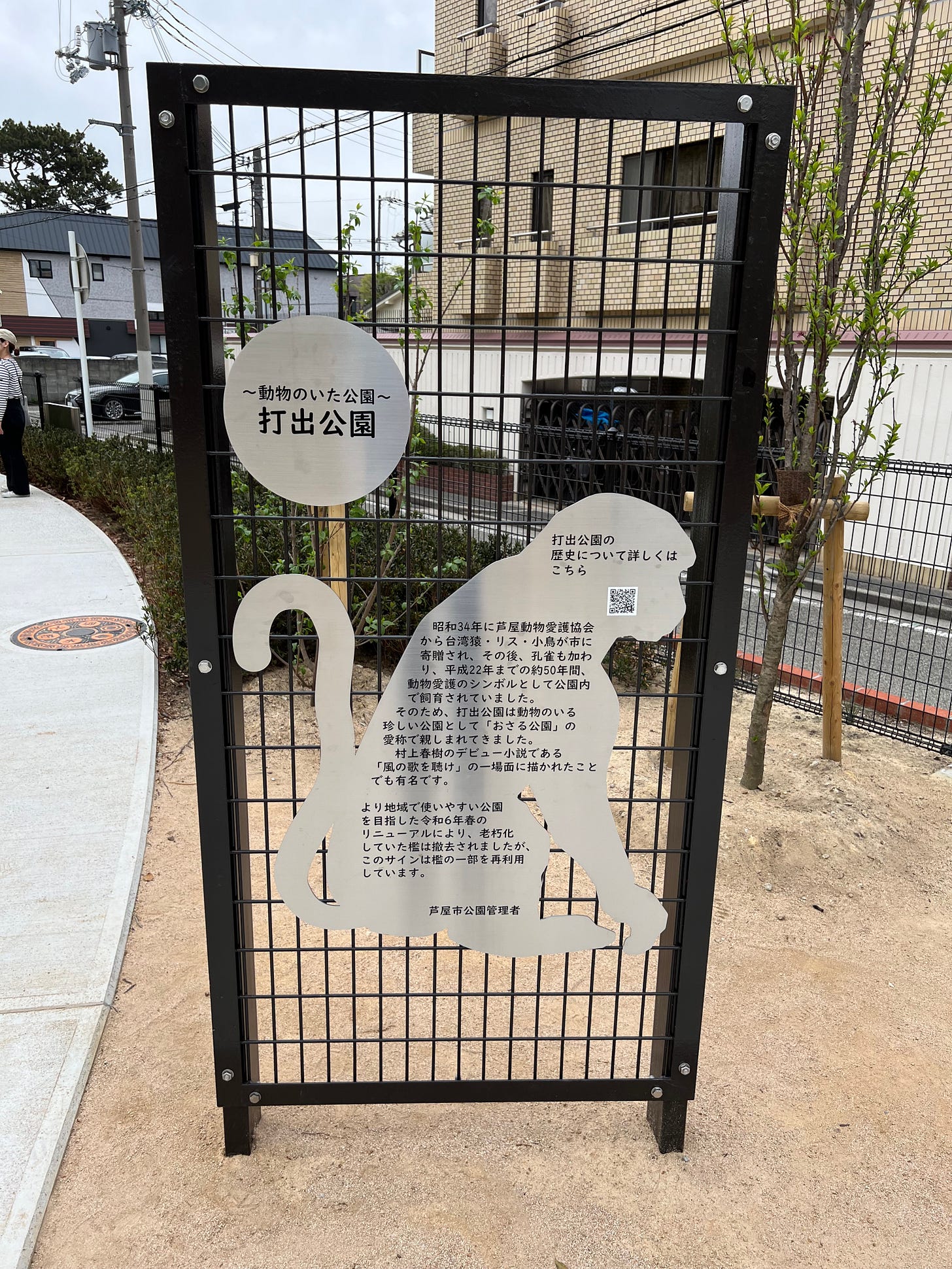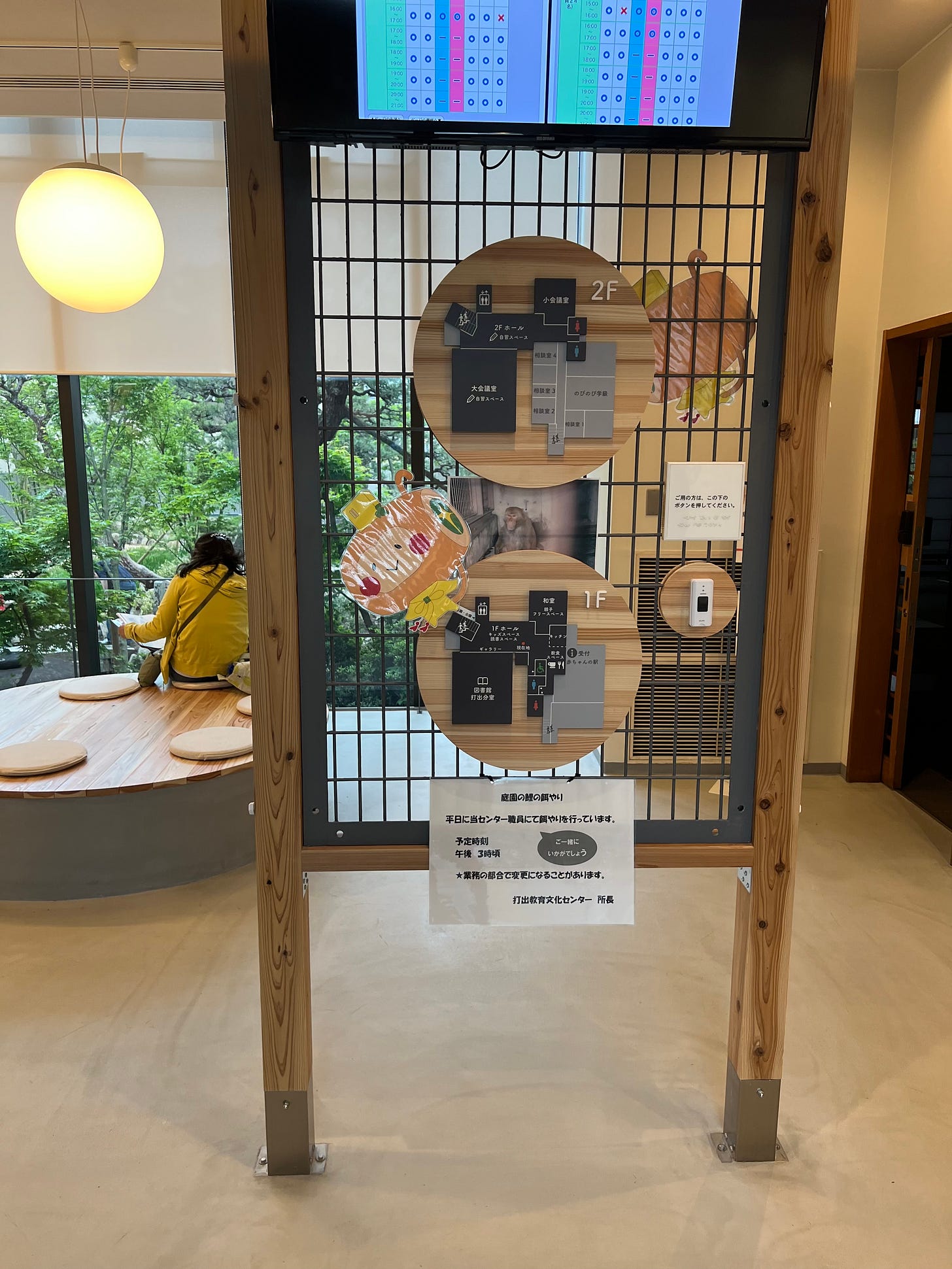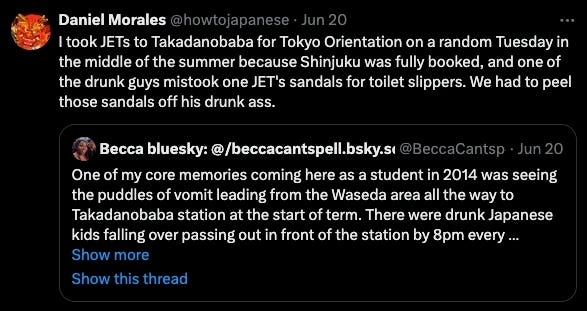This is How to Japanese, a monthly newsletter with something about Japan/Japanese and a dash of いろいろ.
日本・日本語: Finding Movement
You don’t have to study a language very long to start feeling the generation gap. In college, I learned about コギャル語 (kogyarugo, school gyaru language), which is all but extinct, and these days it’s all 推し活 (oshikatsu, lit. “activities to support your oshi”) all the time. The only 推し (oshi, favorite band member/artist/celebrity) I can really claim are Okamotos Kanoko and Taro and Murakami Haruki, although the term feels so young and new to me that I’m not sure whether they count as 推し. Judging from this tweet, Murakami at least is legitimately up for debate:
チグハグな感じがする (chiguhagu na kanji ga suru, Seems a little strange/inconsistent) indeed.
推し is associated with girl/boy bands (and choosing a favorite from the crowd), but the term feels so prevalent recently that it must have mutated to expand beyond those bounds. This 2023 article uses it in regard to anime characters, and in close succession includes the term 聖地巡礼 (seichi junrei, pilgrimage of “holy” spots). The article talks about the reemergence of travel after COVID and the subsequent economic effects. There does seem to be a noticeable uptick in the Google Trends data for 聖地巡礼:
I put “holy” in quotes above because these are not religious sites that people are visiting. They’re largely sites that are used in anime, such as the staircase at Suga Shrine from 君の名は (Your Name). The English Wikipedia article about 聖地巡礼 is quite good and as of April 2024 seems to be an almost direct translation of the Japanese article (or vice versa).
At any rate, I won’t split hairs over whether or not Murakami qualifies. He’s my 推し, even if I have become a more intense critic (some may even say a hater, but I say they don’t get the joke) over the past 15 years.
I’m loathe to give credit to the Sankei for anything, but the article above does indirectly point to one of the most important aspects of 推し活 and 聖地巡礼: They generate movement and action, both of which are critical for language study.
Language study is not something that will happen to you passively. There are passive ways of intaking the language, of course, but even deciding to tune in to a podcast or turn on the TV to watch NHK requires an initial action. If you’re not willing to make some sort of investment, you are unlikely to get very far with your studies.
Which is why acquiring some sort of 推し, something or someone that you can be actively invested in, something or someone that will motivate you to get off the couch and go out into the world to see, hear, read, and speak Japanese, is an incredibly valuable way to ensure you have the momentum needed to acquire fluency.
I recently did my own Murakami 聖地巡礼. On a cloudy Saturday in April, I took the train to Ashiya Station and started walking. The destination I had in mind was Nishinomiya to the east, if I could make it that far, but I first headed a few blocks south and then west along the tree-lined streets of Ashiya to Henri Charpentier, a patisserie founded in 1969 and named after the creator of Crêpes Suzette.
I was feeling a little self conscious and was glad when they offered to prepare the crêpes in the kitchen, although I was equally glad I could watch the pyrotechnic performance out of the corner of my eye for a couple that had come in around the same time.
Ashiya, a wealthy suburb between Sannomiya and Nishinomiya, is somewhat well known as Murakami Haruki’s hometown, and a young Murakami apparently came on dates to this small shop. He claims there was nothing but residential areas back when he grew up, that a whole host of buildings has been put up in the area, but I didn’t see all that much. Mostly small, multi-family apartment buildings, some single family homes, with a good number of fashionable cafes and boutiques that were centered on the main avenues.
I’d been meaning to visit Ashiya for a while and had put it off. The patisserie I’d only learned about that morning, but it felt like the best place to start that afternoon as I was a little hungry. Revived with the sugar and a jolt of caffeine, I made quick work of the Tanizaki Jun’ichiro Memorial Museum of Literature before it closed and then continued my walk east.
I threaded my way through quiet residential areas that looked very similar to neighborhoods in Osaka, even the one I currently live in. The only differences I could make out were that Ashiya’s were more pristine: There was more space, fewer (read: no) small companies or industrial properties in the residential areas, and noticeably more trees. The neighborhood didn’t smack of wealth, but the area feels notable for what has been kept out of the neighborhood rather than the properties themselves.
Although, as I went north under the Hanshin Expressway, parts of which had toppled in the 1995 earthquake, I could see terraced mansions in the neighborhoods on the sides of Mt. Rokko. Ashiya is a long, narrow municipality stretching from Osaka Bay all the way up to the hills, and as best I can tell the wealth only increases as you go up. Murakami grew up south of the expressway, near the only part of the town that changed: the port and the beach, which have been built in and industrialized to a degree.
It’s unfortunate that I didn’t make my trip sooner. Past a small 商店街 (shōtengai, shopping arcade), also in pristine condition with a few lovely cafes and a still-operating 八百屋 (yaoya, green grocer), is Uchide Park, which Murakami memorialized in Hear the Wind Sing as “the park with a monkey cage.”
Up until last year, this was the kind of park you’d expect in urban Japan: a barren patch of dirt with a few benches and some aging equipment for children to climb on. The empty monkey cage was the only thing that stood out. Uchide Park was home to squirrels and birds in addition to monkeys starting in 1959. This ended in 2010 (with the last monkey dying in 2003), but the cage remained until last year when the town finally renovated the place and got rid of it.
When I learned I’d just missed it, I felt sick. Like I’d missed a critical window of history. The cage is a minor piece of trivia, not something that would ever stand the test of time, nor was it ever meant to, but I think that’s the point. It’s an emblem of that particular period of time and this particular community. How many neighborhoods in Japan had the financial capacity to even consider housing monkeys? The cage wasn’t the point. It’s what the cage stood for. And now this physical representation of that period was just out of reach.
I managed to pump myself up to make the trip anyway, using the excuse that I’d be able at least to see how the renovation looked. It’s much nicer obviously. The park itself, which I didn’t take photos of because there were so many people and children using it, is a basic Japanese park, clean and unremarkable, but I’m sure it’s more frequently used now, and there’s a nice Japanese garden and a beautiful community center attached to the neighboring library, with space to sit and do nothing for no cost at all, which is rare to find these days.
I did a lap, took a photo of the sign made with a recycle piece of the monkey cage, did a quick tour of the library and community center, and then headed back south of the expressway to walk past Murakami’s elementary and junior high schools before heading home.
I didn’t use all that much Japanese that day, but I used more than I would’ve otherwise because I got out of my living space, went out into the world to a cafe and a museum.
The one downside of 聖地巡礼 is that ultimately they require movement to Japan. 推し活 are a bit more egalitarian in that you can actively participate remotely.
So this is your モーニングコール (lit. “morning call” = wakeup call). If you don’t already have an 推し, it’s time to find one, even if it’s something unconventional like a news announcer, a TikToker, or a lesser known manga artist. Something that will motivate you to continue consuming language content in some form out in the world. Having an 推し is critical to maintaining a long-term interest in the language.
いろいろ
Check out the podcast for an audio version of this newsletter and more. Also, this is the blog post I based my Ashiya pilgrimage on.
Diamond has a really interesting article about whether おもてなし (omotenashi, hospitality) is a Japanese concept and the effects of overpromising on the tourism industry. Mulboyne has a nice thread breaking down the points in English.
The JPY exchange rate-tracking Twitter account is back. I believe it took a break when automated accounts were limited, but it’s nice (albeit painful) to stay more updated on the current rate.
There was Takadanobaba discourse:
The Erdtree has cast its shadow across the land, and I, too, will bask in it this weekend. Tag me on Twitter if you want to try and get a coop match in!














Quite a surprise to find my old hometown of Ashiya in a Substack. I lived there from 1982 to 2011, when I moved to Tokyo to more easily report on the aftermath of the triple disaster in Tohoku.
Your observations about wealth in Ashiya are correct. One has indeed to go up into the mountains to encounter it.
I gathered from your account that you arrived at JR Ashiya Station? As there are three Ashiya Stations the locals always add the railway name. If it is omitted it is assumed it is JR Ashiya.
Your walk to the old Henri Charpentier shop (I used to visit often in the 1980s—lovely memories!) took you away from the mountains to the area close to Hanshin Ashiya Station.
The area along the Hanshin Railway line is traditionally considered the least wealthy in Ashiya, as you observed. The wealth improves in the area between the JR and Hankyu lines, and is highest from Hankyu into the mountains.
Rokurokuso (六麓荘), nestled high in Ashiya’s mountains, is known as one of the most exclusive residential areas in Japan.
As it happens, the area between JR and the sea is mostly alluvial and therefore experienced the greatest destruction from the 1995 Hanshin Awaji Great Earthquake.
As usually happens with disasters—both natural and human-made—the least wealthy were hit worst. Whole neighborhoods along the Hanshin Railway line, even complete shopping streets, disappeared. A lot of the buildings you saw on your walk were likely built since then.
The geographically more stable area in the mountains experienced relatively little damage and still features many old buildings that exude wealth and history.
I used to walk to the monkeys once in a while and didn’t realize that they were no longer there. Just as well for the poor monkeys, but it does feel like a door to the past has been closed now the cages are gone. The park was always buzzing with the voices of children; hopefully that won’t change.
Thank you for taking me back to the town that I still consider home.
You make a great point about language acquisition that I can relate to, Daniel. When I was teaching English in Nishinomiya high schools in 1986, I wasn’t supposed to use Japanese in class, all my fellow English teachers wanted to speak to me in English. I chose baseball (Hanshin Tigers) as my 推しand sought out fellow fans in the staff room to chat about it.